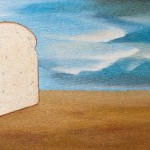Matthew 4:1-11
Baptism-Fasting-Feasting.
This is the pattern of the life of Christ in Matthew 4, and it is the pattern of our lives as well. You can even see this pattern in the Church Year that the church has created and preserved. Advent and Christmas are kinds of baptisms or new beginnings: Advent is the initiation of the church year in which we prepare for Christ, and Christmas is the initiation of the life of Christ, whose life we join ourselves to. Epiphany is an extension of the life of Christ and Incarnation, and then come the weeks before Lent and Lent, which is the period of fasting. This fasting leads to a climax and crisis of Good Friday, and then comes the glorious feast of Easter in which we leave the fast behind and celebrate the new life that God has given. Trinity, the green season of growth, is a season of lesser feasting, as we continue to celebrate this new life.
But here, in Matthew 4, the pattern is laid down in the life of Jesus. In verse 1 we read that, “Jesus was led up by the Spirit into the wilderness.” Jesus didn’t rush out into the wilderness to be tempted by the devil of his own accord: He was led there by the Spirit. And where is it that we find Christ first filled with the Spirit? After his baptism. This may seem puzzling at first, since I’ve said that the pattern of the life of Christ is Baptism, Fasting, and Feasting, and in Matthew 4 there appears to be a fast without a baptism before it. If we read the Gospel of Matthew as an entirety, and not a collection of verses and chapters (which were added later), we wouldn’t miss such patterns.
In the book of Exodus, we find that this pattern of fasting and temptation applies not only to Christ but also to Moses, as the mediator of the Old Covenant. In Exodus 14 Moses leads the Israelites through the Red Sea, which represented their baptism. Not only do we have the obvious water symbolism represented here to confirm that this is a baptism, but we also have the testimony of Paul in 1 Corinthians 10:2 that “all were baptized unto Moses in the cloud and in the sea.” Immediately following the baptism of the Israelites, they fasted, or were tempted for forty days. There are two aspects of this fasting. First, Moses himself fasted for forty days and nights on the mountain of God, as Exodus 34 tells us. As the mediator of the Old Covenant, it is not surprising that Moses should undergo the same kind of fasting and temptation which His Master was to undergo. (It’s interesting that Christ, Moses, and Elijah, all of whom appeared on the mount of transfiguration, had all first undergone 40 day periods of fasting.)
The second fasting that takes place involves the Israelites. Even as Moses was fasting and receiving the Law for 40 days, the people faced a different kind of fasting and temptation. They were without their godly representative for forty days and nights. How would they handle this time without their leader upon whom they depended for everything? The answer is all too clear. They broke the fast and set up a golden calf to be their leader and god in Moses’ absence. This failure on the part of the Israelites led to another testing period of 40, this time the 40 years of wandering in the wilderness.
But Jesus succeeded where the Israelites, and even Moses, could not, for even Moses was tempted in the wilderness to smite the rock of water twice, and so was disabled from leading the children into the Promised Land. It was Joshua, which is only another form of the name Jesus, who was to lead them into the Promised Land.
Now it’s interesting to me that the same Spirit with which Jesus has been baptized is the one who immediately leads him into the wilderness — to be tempted. Maybe that isn’t as startling to us as it ought to be. The Spirit of God which baptizes us also leads us into the wilderness after baptism to be tempted and tested. We don’t usually hear much about this aspect of the Spirit’s ministry. In fact, sometimes when we face trials and temptations it’s assumed that they occurred because of a lack of the Spirit in the life of a believer. But God’s Holy Spirit has a purpose in leading His people into the wilderness.
Let’s look more closely at how Christ was tempted after His baptism and how He endured it.
Verse 2 says, “And when He had fasted forty days and forty nights” (and here comes an understatement so extraordinary it seems almost comical), afterward, he was hungry”!! So Jesus was already engaged in one kind of temptation even before Satan showed up. In denying Himself food for 40 days Jesus was at the same time subjecting himself to the temptation to break the fast He was to endure.
Satan’s first temptation was only an intensification of a temptation Christ was already enduring. It was an appeal to the desires of the flesh which Satan brought to Christ’s mind in a new way. But Christ rebuked Satan with Scripture. And Jesus had bread that Satan did not know. He had the Word of God, and He had the food of doing the will of the Father (John 4:34), which sustained Him, in spite of temptation. Romans 10:8 states that, “The word is near you, even in your mouth.” Indeed, the Word of God was so near to Jesus and His mouth that it was what sustained Him during His fasting. Man shall not live by bread alone but by every word of God. Jesus was not alone in His fasting; instead, He was accompanied by the Word of God, and the Father and His will, and we can be sure that He occupied His time in prayer as well. With these weapons did Jesus subdue the Tempter.
Satan’s second attempt to seduce Jesus was the temptation to doubt. This was, perhaps, the most subtle of Satan’s temptations. After all, what could possibly be wrong with Jesus fulfilling Scripture and casting himself down? Surely the angels of God would save Him. But this is the same temptation which Satan planted in the mind of Eve and to which she succumbed. “Hath God said?” was Satan’s question to her. Did God really say that you couldn’t eat from the Tree of the Knowledge of Good and Evil?
Satan’s third and final attempt was an appeal to riches and power, the temptation of the world. Satan wanted Jesus to accept an easy glory that came from his hand, instead of the difficult and costly glory which must come from the Father. Jesus’ response is the same which he offered to Peter, when Peter attempted to seduce Him from walking the path to the Cross: “Get behind me Satan.” “For thou shalt worship the Lord thy God, and him only shalt thou serve.” It is the spirit of Satan that attempts to have us serve anything but God.
Once again, Jesus dispatches Satan through His use of Scripture.
And so the story ends. The good guy wins again. End of story.
OR IS IT?
So far we have seen that after Baptism will come Fasting. But Fasting itself gives way to Feasting. The period of Fasting which Christ endured, which we must endure and which we celebrate particularly in Lent but also throughout all of our lives, will end.
In verses 17 and following, the verses immediately after today’s lesson, we read that Jesus began to preach, saying, “Repent, for the kingdom of heaven is at hand!” He then calls the disciples who were fishermen to become fisher of men, and beginning in verse 23 He goes about Galilee teaching, preaching, and healing. Christ’s period of Fasting prepared Him for His public ministry here on earth, in which He was greatly glorified. And during this time, as the disciples of John the Baptist discovered, there was Feasting as well.
Likewise, the period of feasting for the Israelites began when they entered the Promised Land after being tested in the wilderness for 40 years. Their 40 year fast, like the 40 days of Christ and the 40 days of Lent, were not in vain. It was during this time that God was preparing them for holy warfare against the Canaanites. They entered the Promised Land, the land flowing with milk and honey and enormous pomegranates and figs, ready to do God’s will on the earth.
Well what about us? Does this pattern of Baptism-Fasting-and Feasting apply to us? We’ve seen how it’s found the life of Moses and Israel, the life of Jesus, and in the church year, which rehearses the life of Christ for us. But it’s also found in the life of the church, even if there were no church calendar. For the church, both individually and corporately, is baptized into the name of Christ. Once we are baptized, we immediately enter into a period of fasting, which, in a way, is to last the remainder of our earthly lives.
The early church recognized the connection between baptism and fasting and temptation in its baptismal services, into which was incorporated an exorcism or a putting off of the devil. This is reflected in the Book of Common Prayer in the service of baptism. Here the minister asks those to be baptized “Dost thou renounce the devil, and all his works, the vain pomp and glory of the world, with all covetous desires of the same, and the sinful desires of the flesh, so that thou wilt not follow, not be led by them?” And again, “We receive this person into the congregation of Christ’s flock; and do sign him with the sign of the Cross, in token that hereafter he shall not be ashamed to confess the faith of Christ crucified, and manfully fight under his banner, against sin, the world, and the devil.”
In a way, then, all of our life is a season of fasting, for as Mark 2:20 reminds us, a day will come when the bridegroom will be absent and the bride will fast. While the Lord is absent, we must fast and put off the deeds of the flesh. There is, for the life of the believer, as long as he shall live here on earth, a perpetual Lent, a perpetual fasting.
Mardi Gras is a traditional celebration that developed along with the tradition of Lent, but its roots are also in pagan festivals such as the Saturnalia, bacchanalia, and carnival. Mardi Gras, which means “Fat Tuesday” and whose slogan is “Let the good times roll,” is the day before Ash Wednesday. Since Ash Wednesday, as the first day of Lent, meant a temporary end to the pleasures of this world, Fat Tuesday became a day when all of those pleasures, sometimes including illicit ones, were filled.
But this is exactly backwards. We fast first, and then we feast. Lent, and then Easter. Some contemporary sermons and even entire worship services make a similar mistake. They begin with feasting and end with feasting. They have no desire to fast or to observe Lent. Heck – they won’t say a confession of sin or even sing songs in a minor key! Life is good. Let’s eat, drink, and be merry. Let the good times roll because health and wealth are just around the corner!
The Israelites, when Moses was receiving the very oracles of God, did not keep the fast either, but chose to enjoy the pleasures of sin and make a false idol. As Paul quotes in 1 Corinthians 10:7, “The people sat down to eat and drink, and rose up to play.”
Just as the church must proceed from baptism to fasting, it must also anticipate going from fasting to feasting. When Christ the Bridegroom returns, then the church His Bride will feast. You all, if you truly believe on the name of Christ, are invited to the Marriage Feast of the Lamb. As we proceed from fasting to feasting, let us keep in mind that after we have endured the years of the wilderness we shall enter the Promised Land.
This is not just the pattern of our lives on the grand scale but on a daily basis. Every time we begin to draw closer to Christ and initiate a new life in Him, we are often tempted, and often a time of fasting comes. But if we persevere and eat the Bread of Heaven, the Word of God, and the bread of obedience, we will be sustained and our lives will turn into a feast.
Yes, even in this life, there is, ultimately, feasting because He who is the Bread of Life offers Himself to us every day. Although in this life it is mixed with the fast, the feast which is Christ is also always offered to us. Some of us even get to see this pattern in the week of fasting from the Lord’s Table and heavenly food, and then the Feast of the Holy Communion.
Baptism-Fasting-and Feasting. It was God’s pattern for Christ’s life, and it is His pattern for our lives.
Prayer: Father, I praise You for baptizing me into Your Son and the Name of the Holy Trinity; I thank You for sharing Your life with me. When I am fasting, remind me that to do Your will is my food, according to Your Word. When I am feasting, remind me that You are the giver of every good gift. In all things, unite me with Yourself, through Your Son, Jesus Christ my Lord. Amen.
Point for Meditation: Where are you in the cycle of Baptism-Fasting-Feasting? What is it that the Lord would have you do in this place? If you have initiated a renewed life in Christ, meditate on what He is asking of you. If you are in a period of fasting, meditate on how you should be sustained during this time. If you are in a period of feasting, then rejoice and give thanks!
Resolution: I resolve to meditate on where my life in Christ is at this moment and, having meditated, to respond appropriately, recognizing that He is with me in all times and circumstances.
© 2016 Fr. Charles Erlandson















